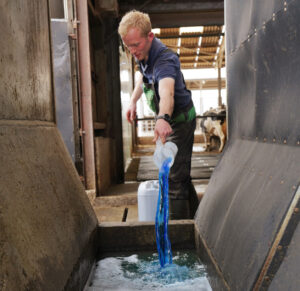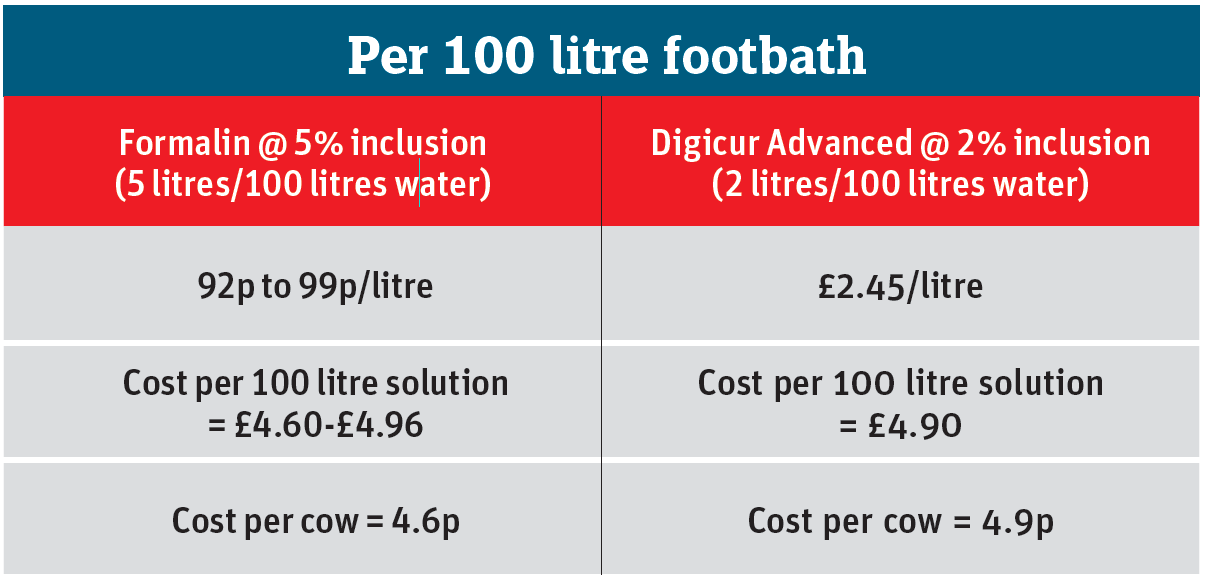This easy-to-use, non-carcinogenic, low-odour option is the same cost as the one you use now.
Foot health and reducing lameness with regular hoof care is one of the cornerstones of productivity and animal welfare for dairy herds. One of the most effective tools for preventing and controlling hoof problems—especially lameness caused by infectious diseases— is regular footbathing.
While it may seem like a routine chore, foot bathing plays a crucial role in maintaining herd health, milk yield, and overall farm profitability.
Why footbath cows?
Day-to-day cows are on their feet a lot —walking to feed, water, milking parlours, and in loafing areas. Hoof issues, which can lead to lameness, can be as a result of damage in the environment – a bruised sole or puncture wound – or infectious conditions especially digital dermatitis, foot rot, and interdigital dermatitis. Any hoof or lameness problem is not only painful but can lead to:
- Reduced feed intake
- Decreased milk production
- Fertility issues
- Early culling
 A regular footbathing program can drastically reduce the incidence and severity of these issues by preventing pathogen buildup and promoting hoof health. The frequency of footbathing matters and whole herd mobility scoring every six to eight weeks will help set a baseline for a herd, after which a hoof health plan can be made. Some experts estimate that for every cow with a mobility score of three, there’s probably another two or three with scores hovering around two which may be going unseen.
A regular footbathing program can drastically reduce the incidence and severity of these issues by preventing pathogen buildup and promoting hoof health. The frequency of footbathing matters and whole herd mobility scoring every six to eight weeks will help set a baseline for a herd, after which a hoof health plan can be made. Some experts estimate that for every cow with a mobility score of three, there’s probably another two or three with scores hovering around two which may be going unseen.
“Increasingly, we see that farmers are opting to bring in the experts,” says Progiene’s Alison Clark. “This could be a mobility mentor, a hoof trimmer or vet qualified to trim hooves. And the investment in expertise and a consistent approach over time pays off – lameness costs £3.30.cow/day and these losses. “Increasingly, we see that farmers are opting to bring in the experts,”
Once assessed and with lameness records checked, a herd can be categorised as ‘low prevalence’ or ‘high prevalence’.
Foot bathing regime:
1. Low prevalence herds:
Footbathing after four consecutive milkings every two weeks can be effective.
2.High prevalence herds:
Daily footbathing is recommended or, at a minimum and especially during wet periods, at least three – five times per week.
“Ineffective foot bathing can make infectious conditions worse by helping pathogens spread,” points out Alison Clark. “Also, some formulations reduce the hoof’s natural defences, paving the way for infection to take hold.”
Key points
- Maintain a good flow of cows and make sure feet are in contact with the disinfectant solution for long enough.
- Calculate the amount of disinfectant needed for the correct dilution rate foryour footbath size – generally, the best designs for narrow and wide footbaths.
- Good cow flow through a footbath reduces splashing, which wastes less solution while also reducing the risk of teat contamination.
“There is a range of chemicals being used in foot baths, with many still opting for old-fashioned formalin,” says Alison. “But this should come with a warning – over time, it can compromise the integrity of the hoof and it is banned in a few countries due to possible human health problems from carcinogenic fumes if not handled carefully. Used at a 2% dilution rate may be less
effective than the more standard 4% or 5% dilution rate.”
Digicur Advanced is a highly concentrated triple action, broad spectrum liquid disinfectant solution containing glutaraldehyde, chelated copper and zinc and can be used for cattle, sheep and goats. “It contains a unique patented chelate which keeps the copper and zinc in suspension meaning that they work very quickly and breakdowns in the environment.” explains Alison. “Digicur Advanced is used at a 2% dilution which is two litres/100 litres of water and starts to work the moment the hoof comes into contact with it. A unique feature is its long-cling formulation – it contains heavy duty surfactants which means it clings to the hooves after footbathing. “In contrast to formalin, Digicur Advanced is not carcinogenic; making
it far less dangerous to the operator who might be mixing it,” she adds. “And for cows that don’t like the pungent aroma of formalin, Digicur Advanced has a much-reduced odour meaning they are often happier to walk through the foot bath. “Whatever product you choose, one golden rule to remember is to have one litre of solution per cow; this means emptying or replenishing the solution after 100 cows have walked through 100 litres of solution,” Alison explains.
Costs
Digicur Advanced is used at 2% (2 litres per 100 litres water) inclusion and formalin is usually used at a 5% (5 litres per 100 litres water) dilution rate. Using Digicur Advanced works out at around the same cost / cow when compared to formalin at 5%, and it becomes even more costeffective when compared to formalin used at 10% inclusion rate. Digicur Advanced is available in five, 25, 200 and 1,000 litre pack sizes. The chemical components of it are defined as readily biodegradable and it is anticipated that it will achieve 80% degradation in 28 days; also the chelated copper component in the formulation is inherently biodegradable.


